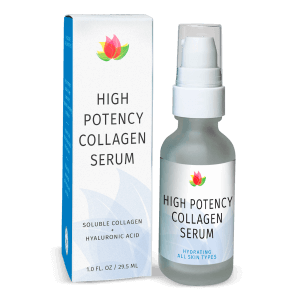Clean Beauty, Natural, Reviva Labs, Skin Care
How Elastin and Collagen Help the Body’s Skin
Every day, our skin tells a story. From the suppleness of youth to the fine lines of experience, our skin reflects the intricate dance of molecules beneath its surface. At the heart of this dynamic process are elastin and collagen, two powerhouse proteins that shape the strength, resilience, and elasticity of our skin.
The Cornerstones of Skin Structure
Collagen and elastin are often referred to as the building blocks of the skin, and for good reason. These proteins reside in the dermis, the middle layer of skin, forming a scaffold that supports skin integrity.
Collagen is the skin’s primary structural protein, accounting for about 75% of its dry weight. It acts like the framework of a building, providing tensile strength and ensuring the skin remains firm and smooth. Without adequate collagen, skin becomes fragile, leading to sagging and the formation of wrinkles.
Elastin, on the other hand, brings elasticity and resilience to the table. Think of elastin as the rubber band of the skin. It allows skin to stretch and bounce back to its original shape. Whether you’re smiling, frowning, or moving your limbs, elastin ensures your skin maintains its youthful pliability.
How These Proteins Change Over Time
As we age, collagen and elastin production naturally decline. By the age of 20, the body begins to produce about 1% less collagen each year. Elastin production also diminishes, and the fibers can lose their ability to stretch and recoil effectively. This results in thinner skin, reduced elasticity, and the appearance of wrinkles.
Environmental factors like ultraviolet (UV) radiation, pollution, and lifestyle choices such as smoking or poor nutrition exacerbate this process. UV rays, in particular, break down collagen and elastin fibers in the skin’s dermis. This process, known as photoaging, accelerates the visible signs of aging.
Collagen: The Skin’s Firm Foundation
Collagen exists in several forms within the body, but for skin, Collagen Types I, III, and IV are most critical. These types:
- Enhance skin firmness.
- Aid in wound healing.
- Support hydration by binding water molecules.
Interestingly, collagen production is a continuous process. Fibroblasts, the cells responsible for producing collagen, work tirelessly to repair and replenish the skin. However, their activity slows over time. Supporting fibroblast activity through proper skincare and nutrition is essential for maintaining youthful skin.

Elastin: The Secret to Bounce
Elastin is made up of amino acids that form crosslinked fibers, allowing it to act like a spring within the skin. This unique structure provides elasticity that can withstand countless stretches and recoils over a lifetime. While less abundant than collagen, elastin’s role is equally critical for skin that feels youthful and resilient.
Unfortunately, the body’s ability to synthesize elastin diminishes significantly after puberty. This means that once elastin fibers are damaged, they are not easily replaced. This is why protecting elastin through preventive measures is vital for long-term skin health.
Supporting Collagen and Elastin for Radiant Skin
While the natural aging process is inevitable, several strategies can help preserve and even boost collagen and elastin levels:
Nutrition
Certain nutrients are essential for collagen and elastin production:
- Vitamin C is a key player in collagen synthesis. It activates enzymes that stabilize the collagen molecule and neutralizes free radicals that can degrade collagen and elastin.
- Protein-rich foods provide amino acids like proline and glycine, which are building blocks for these proteins.
- Antioxidants, found in foods like berries and green tea, protect skin cells from oxidative stress.
Topical Treatments
Advanced skincare formulations can directly support these proteins:
- Peptides signal the skin to produce more collagen, helping to firm and smooth the surface.
- Retinoids enhance collagen synthesis and improve skin texture.
- Hyaluronic acid, a hydrating molecule, works synergistically with collagen by keeping the skin’s extracellular matrix plump and moist.
- Sunscreen is arguably the most critical product for protecting existing collagen and elastin. Daily use of a broad-spectrum SPF minimizes UV-induced damage.
Professional Treatments
Medical and cosmetic interventions can stimulate the skin’s natural repair mechanisms:
- Laser therapy targets the dermis, encouraging fibroblast activity and boosting collagen production.
- Microneedling creates controlled micro-injuries to prompt the skin to repair itself with fresh collagen and elastin.
- Radiofrequency treatments deliver heat to deeper layers of the skin, stimulating collagen remodeling.
The Role of Lifestyle
Skin health doesn’t operate in a vacuum; it reflects overall well-being. Adequate sleep, stress management, and hydration all play pivotal roles in supporting collagen and elastin. Smoking cessation and minimizing alcohol consumption can also slow the degradation of these proteins.
Collagen and Elastin in Skincare Products
The beauty industry has long harnessed the power of collagen and elastin in topical products. While these proteins themselves are too large to penetrate the skin’s surface, hydrolyzed versions can offer surface-level hydration. Products containing precursors or stimulators of collagen and elastin production—like Reviva Labs’ Elastin Collagen Toner—help prepare the skin to absorb active ingredients more effectively, enhancing its natural regenerative processes.
Why It Matters
Healthy collagen and elastin levels don’t just affect how skin looks—they influence how it feels and functions. Skin with robust structural proteins is better equipped to defend against environmental stressors, heal from injury, and retain moisture. Investing in practices and products that support these proteins is a commitment to both the present and future health of your skin.
Final Thoughts
Collagen and elastin are more than skin deep. They’re vital to maintaining the skin’s youthful appearance and functional resilience. By understanding their roles and taking actionable steps to protect and enhance them, you can ensure that your skin’s story continues to be one of strength, elasticity, and vitality—no matter your age.










